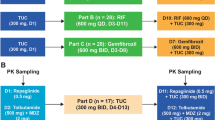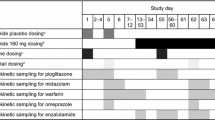Abstract
Background and Objective
Vandetanib is a selective inhibitor of vascular endothelial growth factor receptor (VEGFR), epidermal growth factor receptor (EGFR) and rearranged during transfection (RET) signalling, indicated for the treatment of medullary thyroid cancer. We investigated potential drug–drug interactions between vandetanib and metformin [organic cation transporter 2 (OCT2) substrate; NCT01551615]; digoxin [P-glycoprotein (P-gp) substrate; NCT01561781]; midazolam [cytochrome P450 (CYP) 3A4 substrate; NCT01544140]; omeprazole (proton pump inhibitor) or ranitidine (histamine H2-receptor antagonist; both NCT01539655).
Methods
Four open-label, phase I studies were conducted in healthy volunteers: n = 14 (metformin), n = 14 (digoxin), n = 17 (midazolam), n = 16 (omeprazole), n = 18 (ranitidine). Three of these comprised the following regimens: metformin 1000 mg ± vandetanib 800 mg, midazolam 7.5 mg ± vandetanib 800 mg, or digoxin 0.25 mg ± vandetanib 300 mg. The randomized study comprised vandetanib 300 mg alone and then either (i) omeprazole 40 mg (days 1–4), and omeprazole + vandetanib (day 5); or (ii) ranitidine 150 mg (day 1), and ranitidine + vandetanib (day 2). The primary objective assessed metformin, digoxin, midazolam and vandetanib pharmacokinetics.
Results
Vandetanib + metformin increased metformin area under the plasma concentration–time curve from zero to infinity (AUC0–∞) and maximum observed plasma concentration (Cmax) by 74 and 50 %, respectively, and decreased the geometric mean metformin renal clearance (CLR) by 52 % versus metformin alone. Vandetanib + digoxin increased digoxin area under the concentration-time curve from zero to the last quantifiable concentration (AUC0–last) and Cmax by 23 and 29 %, respectively, versus digoxin alone, with only a 9 % decrease in CLR. Vandetanib had no effect on midazolam exposure. Vandetanib exposure was unchanged during co-administration with omeprazole/ranitidine. Treatment combinations were generally well tolerated.
Conclusion
Patients receiving vandetanib with metformin/digoxin may require additional monitoring of metformin/digoxin, with dose adjustments where necessary. Vandetanib with CYP3A4 substrates or omeprazole/ranitidine is unlikely to result in clinically relevant drug–drug interactions.


Similar content being viewed by others
References
Wedge SR, Ogilvie DJ, Dukes M, et al. ZD6474 inhibits vascular endothelial growth factor signaling, angiogenesis, and tumor growth following oral administration. Cancer Res. 2002;62:4645–55.
Carlomagno F, Vitagliano D, Guida T, et al. ZD6474, an orally available inhibitor of KDR tyrosine kinase activity, efficiently blocks oncogenic RET kinases. Cancer Res. 2002;62:7284–90.
Ciardiello F, Caputo R, Damiano V, et al. Antitumor effects of ZD6474, a small molecule vascular endothelial growth factor receptor tyrosine kinase inhibitor, with additional activity against epidermal growth factor receptor tyrosine kinase. Clin Cancer Res. 2003;9:1546–56.
Ferrara N, Davis-Smyth T. The biology of vascular endothelial growth factor. Endocr Rev. 1997;18:4–25.
Kowanetz M, Ferrara N. Vascular endothelial growth factor signaling pathways: therapeutic perspective. Clin Cancer Res. 2006;12:5018–22.
Wells A. EGF receptor. Int J Biochem Cell Biol. 1999;31:637–43.
Thornton K, Kim G, Maher VE, et al. Vandetanib for the treatment of symptomatic or progressive medullary thyroid cancer in patients with unresectable locally advanced or metastatic disease: U.S. Food and Drug Administration drug approval summary. Clin Cancer Res. 2012;18:3722–30.
Martin P, Oliver S, Kennedy SJ, et al. Pharmacokinetics of vandetanib: three phase I studies in healthy subjects. Clin Ther. 2012;34:221–37.
Martin P, Oliver S, Robertson J, et al. Pharmacokinetic drug interactions with vandetanib during coadministration with rifampicin or itraconazole. Drugs R D. 2011;11:37–51.
Weil A, Martin P, Smith R, et al. Pharmacokinetics of vandetanib in subjects with renal or hepatic impairment. Clin Pharmacokinet. 2010;49:607–18.
Estudante M, Morais JG, Soveral G, et al. Intestinal drug transporters: an overview. Adv Drug Deliv Rev. 2013;65:1340–56.
Wang ZJ, Yin OQ, Tomlinson B, et al. OCT2 polymorphisms and in-vivo renal functional consequence: studies with metformin and cimetidine. Pharmacogenet Genomics. 2008;18:637–45.
AstraZeneca. Global policy: Bioethics. 2011. Available from: http://www.astrazeneca.com/Responsibility/Code-policies-standards/Our-global-policies.
Hedenstrom H, Alm C, Kraft M, et al. Intragastric pH after oral administration of single doses of ranitidine effervescent tablets, omeprazole capsules and famotidine fast-dissolving tablets to fasting healthy volunteers. Aliment Pharmacol Ther. 1997;11:1137–41.
Somogyi A, Stockley C, Keal J, et al. Reduction of metformin renal tubular secretion by cimetidine in man. Br J Clin Pharmacol. 1987;23:545–51.
Pentikainen PJ, Neuvonen PJ, Penttila A. Pharmacokinetics of metformin after intravenous and oral administration to man. Eur J Clin Pharmacol. 1979;16:195–202.
Graham GG, Punt J, Arora M, et al. Clinical pharmacokinetics of metformin. Clin Pharmacokinet. 2011;50:81–98.
Motohashi H, Inui K. Organic cation transporter OCTs (SLC22) and MATEs (SLC47) in the human kidney. AAPS J. 2013;15:581–8.
Kusuhara H, Ito S, Kumagai Y, et al. Effects of a MATE protein inhibitor, pyrimethamine, on the renal elimination of metformin at oral microdose and at therapeutic dose in healthy subjects. Clin Pharmacol Ther. 2011;89:837–44.
Holden SN, Eckhardt SG, Basser R, et al. Clinical evaluation of ZD6474, an orally active inhibitor of VEGF and EGF receptor signaling, in patients with solid, malignant tumors. Ann Oncol. 2005;16:1391–7.
Tamura T, Minami H, Yamada Y, et al. A phase I dose-escalation study of ZD6474 in Japanese patients with solid, malignant tumors. J Thorac Oncol. 2006;1:1002–9.
Shen H, Yang Z, Zhao W, et al. Assessment of vandetanib as an inhibitor of various human renal transporters: inhibition of multidrug and toxin extrusion (MATE1 and MATE2K) as a possible mechanism leading to decreased cisplatin and creatinine clearance. Drug Metab Dispos. 2013;41:2095–103.
Morris SA, Hatcher HF, Reddy DK. Digoxin therapy for heart failure: an update. Am Fam Physician. 2006;74:613–8.
Siepmann M, Kleinbloesem C, Kirch W. The interaction of the calcium antagonist RO 40-5967 with digoxin. Br J Clin Pharmacol. 1995;39:491–6.
Acknowledgments
These studies were sponsored by AstraZeneca. Claire Routley, PhD, from Mudskipper Business Ltd, provided medical writing support, funded by AstraZeneca.
Susanne Johansson, Jessica Read, Stuart Oliver, Mark Steinberg, Yan Li, and Paul Martin are employees of AstraZeneca; Eleanor Lisbon, David Mathews and Philip T. Leese declare no conflicts of interest.
Author information
Authors and Affiliations
Corresponding author
Rights and permissions
About this article
Cite this article
Johansson, S., Read, J., Oliver, S. et al. Pharmacokinetic Evaluations of the Co-Administrations of Vandetanib and Metformin, Digoxin, Midazolam, Omeprazole or Ranitidine. Clin Pharmacokinet 53, 837–847 (2014). https://doi.org/10.1007/s40262-014-0161-2
Published:
Issue Date:
DOI: https://doi.org/10.1007/s40262-014-0161-2




